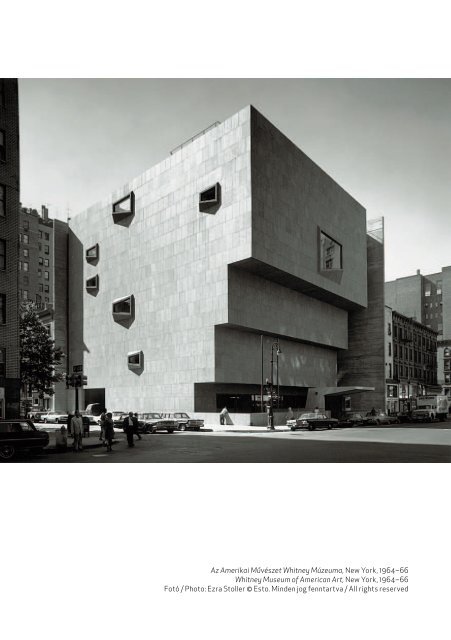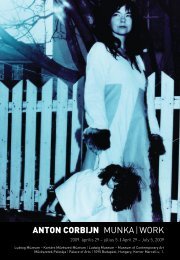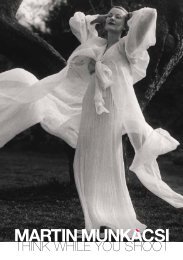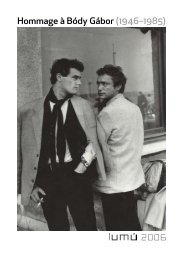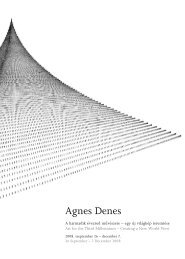Breuer Marcell kiállÃtás 2007 - Ludwig Múzeum
Breuer Marcell kiállÃtás 2007 - Ludwig Múzeum
Breuer Marcell kiállÃtás 2007 - Ludwig Múzeum
Create successful ePaper yourself
Turn your PDF publications into a flip-book with our unique Google optimized e-Paper software.
fémváz a modernizmus szimbólumává avatta<br />
a csőbútort. A Thonet cég már 1929-ben<br />
elkezdte a tömeges gyártását és széles<br />
körben elterjesztette. Az eleinte acélból,<br />
később alumíniumból és rétegelt fából készült<br />
bútor lényege a konzolos erőmegosztás.<br />
A terhelés folyamatosan áramlik szét az<br />
alátámasztás minden pontján. Ezt a konzolos<br />
megoldást használta <strong>Breuer</strong> építészeti munkásságában<br />
is.<br />
1934-ben megpróbált itthon letelepedni és<br />
dolgozni. Bauhaus-diplomáját nem fogadta<br />
el a Magyar Építészkamara, ezért más építészekkel<br />
közösen indult pályázatokon.<br />
A hivatalos szervekkel ellentétben az építésztársadalom<br />
megbecsülte, <strong>Breuer</strong> tagja<br />
volt a leghaladóbb szellemű építészcsoportnak,<br />
a CIAM ‒ Congrès International<br />
d’Architecture Moderne magyarországi<br />
szervezetének, a CIRPAC-nak. A nácizmus<br />
terjeszkedése továbblépésre kényszerítette:<br />
rövid európai vándorlás után Gropius,<br />
a Bauhaus egykori vezetője 1937-ben meghívta<br />
a Harvard Egyetemre tanítani. <strong>Breuer</strong><br />
professzorként óriási pedagógiai munkát<br />
végzett: a Bauhaus-módszereket felhasználva<br />
az amerikai építészek új szemléletű generációját<br />
nevelte ki.<br />
Tíz év tanítás után ismét építészeti tevékenységbe<br />
kezdett. Eleinte Gropius irodájában<br />
dolgozott, 1944-ben pedig saját irodát nyitott.<br />
Ekkor indult nemzetközi építész karrierje,<br />
mely lakóépületektől templomok tervezéséiig<br />
ívelt. Megkapta a Francia Építészeti<br />
purchase his pieces of furniture, they soon<br />
became fashionable in the company of the<br />
avant-garde intelligentsia. The rational formal<br />
creation, the inexpensive streamlined metal<br />
framework initiated the tubular furniture as<br />
the symbol of modernism. The Thonet firm<br />
commenced its mass production in 1929,<br />
so that it would be widely distributed. The<br />
essence of his furniture, produced initially<br />
from steel, later from aluminium and plywood,<br />
was the console distribution of force, with<br />
the load continually circulating across every<br />
point of the support. <strong>Breuer</strong> would employ<br />
this cantilever solution in his architectural<br />
work, as well.<br />
In 1934, he attempted to establish himself and<br />
work in Hungary. His Bauhaus diploma was<br />
not accepted by the Hungarian Chamber of<br />
Architects, therefore he entered competitions<br />
together with other architects. Contrary to the<br />
official organs, the architectural community<br />
respected him, and <strong>Breuer</strong> was a member<br />
of the most progressive-minded group of<br />
architects, the Hungarian organisation of<br />
CIAM - Congrès International d’Architecture<br />
Moderne, the CIRPAC. The expansion of Nazism<br />
compelled him to go further: following<br />
his brief European migration, Gropius, the<br />
former head of the Bauhaus, invited him in<br />
1937 to teach at Harvard University. As a<br />
professor, <strong>Breuer</strong> accomplished enormous<br />
pedagogical work: employing the methods<br />
of the Bauhaus, he educated a generation<br />
of American architects with a completely<br />
new approach.<br />
Az Amerikai Művészet Whitney Múzeuma, New York, 1964‒66<br />
Whitney Museum of American Art, New York, 1964‒66<br />
Fotó / Photo: Ezra Stoller © Esto. Minden jog fenntartva / All rights reserved


